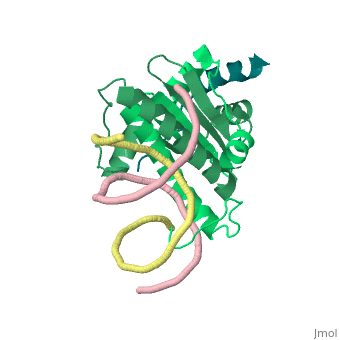Myocyte enhancer factor 2
From Proteopedia
| |||||||||||
3D Structures of myocyte enhancer factor 2
Updated on 10-July-2023
1egw, 1c7u, 3kov – hMEF2A N terminal + DNA – human
3mu6 – hMEF2A N terminal (mutant) + DNA
3p57 – hMEF2A N terminal + DNA + histone acetyltransferase
6c9l – hMEF2B
1n6j – hMEF2B N terminal + DNA + calcineurin-binding protein
1tqe – hMEF2B N terminal + DNA + histone deacylase 9 peptide
6wc5 – hMEF2B + NKX-2.5 + DNA
7x1n – hMEF2D + DNA
5f28 – MEF2C N terminal + focal adhesion kinase 1 - mouse
References
- ↑ Swanson BJ, Jack HM, Lyons GE. Characterization of myocyte enhancer factor 2 (MEF2) expression in B and T cells: MEF2C is a B cell-restricted transcription factor in lymphocytes. Mol Immunol. 1998 Jun;35(8):445-58. PMID:9798649
- ↑ Zhao M, New L, Kravchenko VV, Kato Y, Gram H, di Padova F, Olson EN, Ulevitch RJ, Han J. Regulation of the MEF2 family of transcription factors by p38. Mol Cell Biol. 1999 Jan;19(1):21-30. PMID:9858528
- ↑ Hornstein A, Batts KP, Linz LJ, Chang CD, Galvanek EG, Bardawil RG. Fine needle aspiration diagnosis of ciliated hepatic foregut cysts: a report of three cases. Acta Cytol. 1996 May-Jun;40(3):576-80. PMID:8669199
- ↑ Arnold MA, Kim Y, Czubryt MP, Phan D, McAnally J, Qi X, Shelton JM, Richardson JA, Bassel-Duby R, Olson EN. MEF2C transcription factor controls chondrocyte hypertrophy and bone development. Dev Cell. 2007 Mar;12(3):377-89. PMID:17336904 doi:http://dx.doi.org/10.1016/j.devcel.2007.02.004
- ↑ Cante-Barrett K, Pieters R, Meijerink JP. Myocyte enhancer factor 2C in hematopoiesis and leukemia. Oncogene. 2014 Jan 23;33(4):403-10. doi: 10.1038/onc.2013.56. Epub 2013 Feb 25. PMID:23435431 doi:http://dx.doi.org/10.1038/onc.2013.56
- ↑ Guella I, Rimoldi V, Asselta R, Ardissino D, Francolini M, Martinelli N, Girelli D, Peyvandi F, Tubaro M, Merlini PA, Mannucci PM, Duga S. Association and functional analyses of MEF2A as a susceptibility gene for premature myocardial infarction and coronary artery disease. Circ Cardiovasc Genet. 2009 Apr;2(2):165-72. doi:, 10.1161/CIRCGENETICS.108.819326. Epub 2009 Feb 12. PMID:20031581 doi:http://dx.doi.org/10.1161/CIRCGENETICS.108.819326
- ↑ Pon JR, Wong J, Saberi S, Alder O, Moksa M, Grace Cheng SW, Morin GB, Hoodless PA, Hirst M, Marra MA. MEF2B mutations in non-Hodgkin lymphoma dysregulate cell migration by decreasing MEF2B target gene activation. Nat Commun. 2015 Aug 6;6:7953. doi: 10.1038/ncomms8953. PMID:26245647 doi:http://dx.doi.org/10.1038/ncomms8953

